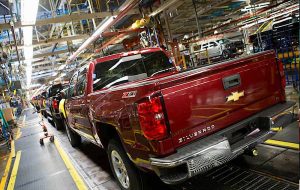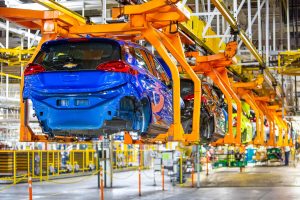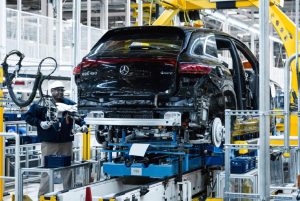General Motors is plowing about $4 billion into plants in Michigan, Tennessee and Kansas during the next two years. The move will shift production of its highly profitable full-size pickups and SUVs from outside the U.S. to its massive plant in Orion, Michigan, north of Detroit.

GM is shifting production of its full-size pickups from its Silao, Mexico plant to Orion, Michigan in 2027.
Without citing the Trump administration’s recent push to avoid recently increased tariffs on its most profitable vehicles, the company plans to move truck production from Mexico and possibly Canada to the site an hour north of Detroit.
The Orion plant was initially designed to handle the production of as many as five different vehicle lines. Most recently, the company began refitting it to handle production of its electric vehicles, including the Chevrolet Silverado EV, GMC Sierra EV and other EVs.
Now, those vehicles will be produced at GM’s Factory Zero at its Detroit-Hamtramck-based plant alongside the GMC Hummer EV truck and SUV. It will also build the all-electric Cadillac Escalade IQ.
These changes won’t hit until sometime in 2027. Officials didn’t reveal how many, if any, new jobs will be created by the moves. However, when the company announced plans to revamp the Orion plant to build EVs in 2022, it said it would create 2,300 new jobs at the previously idled plant.

GM is delayed the reopening of its EV plant in Orion, Township, Michigan by a year. Now it will produce full-size pickups instead of electric vehicles.
Down in Mexico
In addition to moving pickup production to the Orion plant, GM’s moving production of its Chevrolet Blazer from Mexico to its Spring Hill, Tennessee plant that currently builds the Cadillac XT5 SUV, and two all-electric Cadillac utes, the Lyriq and Vistiq.
The company plans to use its Fairfax Assembly plant in Kansas City, Kansas to build the gas-powered Chevrolet Equinox as well as the aforementioned Chevy Bolt EV. The Fairfax facility is also expected to be the home of future “affordable” EV production, according to GM officials.
“We believe the future of transportation will be driven by American innovation and manufacturing expertise,” said Mary Barra, chair and CEO, in a release.

GM put off production of some EV models produced at the Orion Assembly plant to update some tooling and the equipment. Now it will build trucks and SUVs there in 2027.
“Today’s announcement demonstrates our ongoing commitment to build vehicles in the U.S and to support American jobs. We’re focused on giving customers choice and offering a broad range of vehicles they love.”
The company made no reference to tariffs or the Trump administration in its press release, citing instead the company’s “network of 50 U.S. manufacturing plants and parts facilities in 19 states. Nearly 1 million people in the U.S. depend on GM for their livelihood, including employees, suppliers and dealers.”
More GM Stories
- GM-Honda Drift Further Apart on Next-Gen Hydrogen Tech
- GM Announces Potentially Far-Reaching Alliance with Hyundai
- Why Is GM Dumping So Many Seasoned Corvette Execs?
Other movement
 The announcement follows the company’s recently move to invest $888 million at its engine plant in upstate New York. The Tonawanda engine plant will be retooled to produce GM’s next generation of V8 engines. Those new powerplants are expected to go into production in 2027 as well.
The announcement follows the company’s recently move to invest $888 million at its engine plant in upstate New York. The Tonawanda engine plant will be retooled to produce GM’s next generation of V8 engines. Those new powerplants are expected to go into production in 2027 as well.
“No president has taken a stronger interest in reviving America’s once-great auto industry than President Trump,” White House spokesperson Kush Desai said in a statement. “And GM’s investment announcement builds on trillions of dollars in other historic investment commitments to Make in America.”
GM’s 2025 capital spending guidance is unchanged at between $10 billion and $11 billion. Going forward, GM expects its annual capital spending will be in a range of $10 billion to $12 billion through 2027, reflecting increased investment in the U.S., the prioritization of key programs, and efficiency offsets.






I guess someone told Mary what the phrase “Make them where you sell them” means.
You do realize the timeframe needed to set such plans in motion? Much, and likely the vast majority, of what was announced was being planned as far back as 2023.
This seems like a typical Trump “win.” Someone just re-announces what they were going to do anyway. Besides, there will still be lots of parts from Mexico, Canada and elsewhere in all these vehicles, to there will still be a tariff hit, which means these very expensive vehicles will still see price increases.